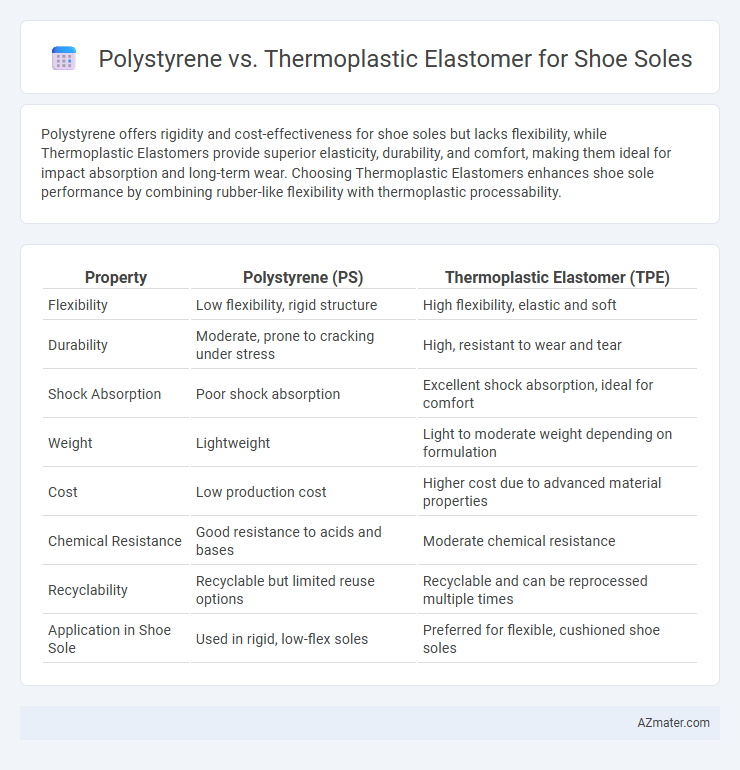Polystyrene offers rigidity and cost-effectiveness for shoe soles but lacks flexibility, while Thermoplastic Elastomers provide superior elasticity, durability, and comfort, making them ideal for impact absorption and long-term wear. Choosing Thermoplastic Elastomers enhances shoe sole performance by combining rubber-like flexibility with thermoplastic processability.
Table of Comparison
| Property | Polystyrene (PS) | Thermoplastic Elastomer (TPE) |
|---|---|---|
| Flexibility | Low flexibility, rigid structure | High flexibility, elastic and soft |
| Durability | Moderate, prone to cracking under stress | High, resistant to wear and tear |
| Shock Absorption | Poor shock absorption | Excellent shock absorption, ideal for comfort |
| Weight | Lightweight | Light to moderate weight depending on formulation |
| Cost | Low production cost | Higher cost due to advanced material properties |
| Chemical Resistance | Good resistance to acids and bases | Moderate chemical resistance |
| Recyclability | Recyclable but limited reuse options | Recyclable and can be reprocessed multiple times |
| Application in Shoe Sole | Used in rigid, low-flex soles | Preferred for flexible, cushioned shoe soles |
Introduction to Shoe Sole Materials
Shoe sole materials vary widely, with polystyrene and thermoplastic elastomers (TPE) being prominent choices due to their distinct properties. Polystyrene offers rigidity and lightweight characteristics but lacks flexibility and impact absorption, making it suitable for casual or dress shoes. Thermoplastic elastomers provide superior elasticity, cushioning, and durability, ideal for athletic and performance footwear where comfort and shock absorption are critical.
What is Polystyrene?
Polystyrene is a synthetic aromatic hydrocarbon polymer made from the monomer styrene, widely used in shoe soles for its rigidity, lightweight properties, and cost-effectiveness. Its structure provides excellent stiffness and excellent resistance to impact, but it lacks flexibility and cushioning compared to thermoplastic elastomers (TPE). In contrast, TPE offers superior elasticity and comfort, making polystyrene more suitable for hard, durable sole components rather than flexible or shock-absorbing applications.
What is Thermoplastic Elastomer (TPE)?
Thermoplastic Elastomer (TPE) is a versatile polymer material combining the elastic properties of rubber with the processability of plastics, widely used in shoe soles for its flexibility, durability, and comfort. Unlike polystyrene, TPE offers superior shock absorption and abrasion resistance, making it ideal for athletic and casual footwear applications. Its recyclability and ability to be molded into complex shapes contribute to sustainable and ergonomic shoe sole designs.
Key Physical Properties Comparison
Polystyrene offers high rigidity and excellent dimensional stability but lacks flexibility, making it less ideal for shock absorption in shoe soles. Thermoplastic elastomers (TPE) provide superior elasticity, abrasion resistance, and better cushioning, which enhances comfort and durability in footwear applications. The choice between polystyrene and TPE fundamentally depends on the required balance between stiffness and flexibility for optimal sole performance.
Durability and Flexibility Analysis
Polystyrene offers high rigidity and impact resistance for shoe soles but lacks flexibility, leading to potential cracking under repetitive bending. Thermoplastic elastomers (TPE) provide superior flexibility and excellent durability through elastic recovery, making them ideal for dynamic movements and long-term wear. Comparative studies show TPE materials maintain structural integrity and cushioning over extended use better than polystyrene, enhancing footwear performance in various conditions.
Comfort and Cushioning Performance
Polystyrene offers lightweight rigidity but lacks the flexibility and shock absorption necessary for optimal shoe sole comfort and cushioning performance. Thermoplastic elastomers (TPE) provide superior elasticity and resilience, enabling better energy return and prolonged comfort during extended wear. Enhanced cushioning properties in TPE soles reduce impact stress, making them ideal for footwear designed with comfort and long-term foot health in mind.
Manufacturing and Processing Differences
Polystyrene (PS) offers ease of injection molding with high dimensional stability but suffers from brittleness, limiting its shock absorption in shoe soles. Thermoplastic elastomers (TPE) provide flexibility and excellent elasticity, enabling extrusion and injection molding with enhanced wear resistance and comfort. Processing TPE requires controlled temperature settings to maintain its elastomeric properties, whereas polystyrene demands lower processing temperatures but often requires additives to improve impact strength.
Environmental Impact and Sustainability
Polystyrene, often used in shoe soles for its lightweight and rigid properties, poses significant environmental concerns due to its non-biodegradable nature and difficulty in recycling, leading to persistent plastic waste in landfills. Thermoplastic elastomers (TPE) offer a more sustainable alternative with better recyclability, reduced energy consumption during production, and potential for reuse, which collectively lower their ecological footprint. Choosing TPE over polystyrene in shoe soles enhances environmental sustainability by promoting circular economy principles and reducing long-term pollution.
Cost-effectiveness for Footwear Brands
Polystyrene offers a low-cost option for shoe soles, making it attractive for footwear brands seeking budget-friendly production without sacrificing basic durability. Thermoplastic elastomers (TPE) provide enhanced flexibility and comfort, often justifying a higher price point due to superior wear resistance and customer satisfaction. Evaluating cost-effectiveness involves balancing initial material expenses with product longevity and end-user comfort, where TPE can yield long-term savings despite a higher upfront cost.
Application Suitability: Choosing the Right Material
Polystyrene offers a rigid, lightweight structure ideal for shoe soles requiring high durability and resistance to wear but lacks flexibility for extensive cushioning. Thermoplastic elastomers (TPE) provide superior elasticity, shock absorption, and comfort, making them suitable for athletic and casual footwear where flexibility and impact resistance are critical. Selecting the right material depends on the specific application needs, balancing stiffness and resilience for optimal shoe sole performance.

Infographic: Polystyrene vs Thermoplastic Elastomer for Shoe Sole
 azmater.com
azmater.com